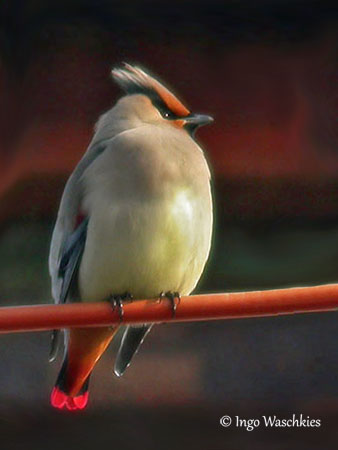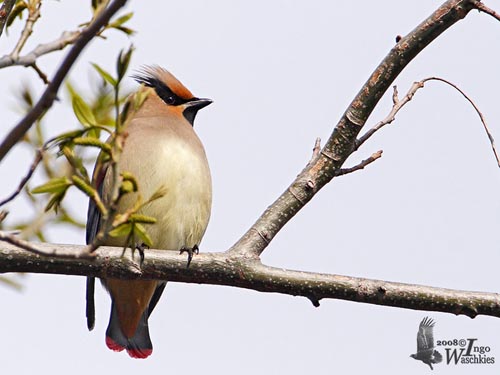
Fr: Jaseur du Japon
All : Blutseidenschwanz
Esp : Ampelis Japonés
Ital : Beccofrusone giapponese
Nd: Japanse Pestvogel
Sd: Amursidensvans
Photographer:
Ingo Waschkies
Bird Photography
Text by Nicole Bouglouan
Sources:
HANDBOOK OF THE BIRDS OF THE WORLD Vol 10 by Josep del Hoyo-Andrew Elliott-David Christie - Lynx Edicions - ISBN: 8487334725
BirdLife International (BirdLife International)
CREAGUS@Monterey Bay (Don Roberson)
Wikipedia, the free encyclopaedia
Japanese Waxwing
Bombycilla japonica
Passeriforme Order – Bombycillidae Family
BIOMETRICS:
Length: 15-18 cm
Weight: 54-64 g
DESCRIPTION:
The Japanese Waxwing is the only member of this small family which lacks the bright red wax-like tips of secondaries.
Adult male has greyish-brown plumage with grey rump. On the wings, the greater wing-coverts are edged bright chestnut on outer webs. Flight feathers are blackish or bluish-grey. Primaries show white tips with sometimes a pinkish-red spot on outer webs, and the outer webs of secondaries may have small red spot at tip. The waxy-tips are usually absent. The tail is blackish or dark grey, with bright pinkish-red terminal band.
Underparts are paler, often yellowish on belly, with reddish undertail-coverts.
On the head, we can see the same backward-pointing crest that in other species. Crown and malar area are warm tawny, contrasting with the black mask, chin and throat.
The bill is blackish. The eyes can be deep red or dark brown. Legs and feet are dark brown.
Outside the breeding season, adults have only white or white-and-pink edges at primary tips.

The female is very similar but slightly paler, with duller undertail-coverts, more ochre. She has reduced or absent red spots at secondary tips.
The juvenile is grey with darker crest, whitish belly and streaked grey flanks.
VOICE: SOUNDS BY XENO-CANTO
The Japanese Waxwing often gives a high-pitched trill, but shorter and slightly higher than that of the Bohemian Waxwing. It also gives high, short and /or long whistles, according to the situation.
HABITAT:
The Japanese Waxwing frequents coniferous forests where it breeds. Its breeding habitat needs fruiting plants too.
It prefers deciduous and mixed forest in winter, and also frequents more open areas with scattered trees, and can be seen in parks and gardens if there are fruiting trees.
RANGE:
The Japanese Waxwing breeds in SE Russia and irregularly in adjacent NE China. Non-breeding birds are found in E China, Korea and Japan.
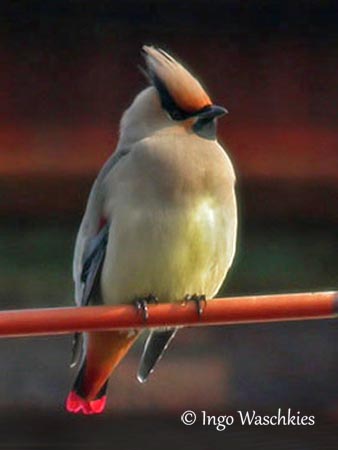
BEHAVIOUR:
The Japanese Waxwing feeds on berries and insects during the breeding season. Outside this period, it takes various fruits, berries and Amur grapes (Vitis amurensis).
It gleans on fruiting trees and bushes, and catches insects probably by aerial flycatching.
There is little available information about breeding and nesting behaviour. Their courtship displays are probably similar to those of the other waxwings, performed with raised crest and fluffed grey rump feathers.
The Japanese Waxwing is short-distance migrant. They arrive at wintering areas in late November, sometimes in early October, and leave them in early April. They reach their breeding grounds in May.
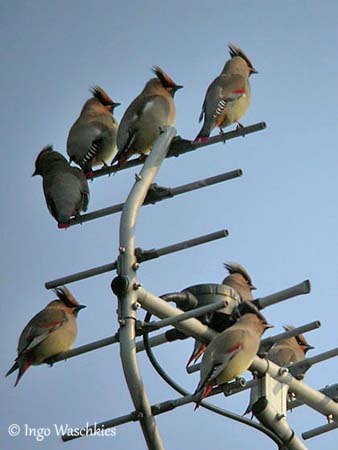
FLIGHT:
The Japanese Waxwing performs fast flight, a direct short flight or slightly undulating over longer distances.
REPRODUCTION:
The breeding season is relatively late. The laying starts in early June and juveniles have been observed at end of August.
This species breeds as individual pairs. The nest is made with twigs of larch and lichens. It is placed at about 8-10 metres above the ground in larch trees.
The female lays 4-6 eggs and incubates. In captivity, incubation lasts about two weeks, and the chicks fledge 16 days after hatching.
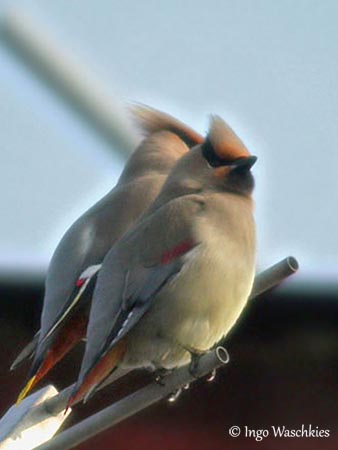
DIET:
The Japanese Waxwing feeds on Vaccinium berries and insects during summer. During the other months of the year, it feeds on various fruits and berries such as mistletoe berries and Amur grapes.
PROTECTION / THREATS / STATUS:
The Japanese Waxwing can be locally common in suitable habitat. It has fairly limited range and small populations.
Changes in its habitat, use of pesticides and other control measures from commercial fruit-growers have involved declines.
This species is currently considered Near Threatened.
